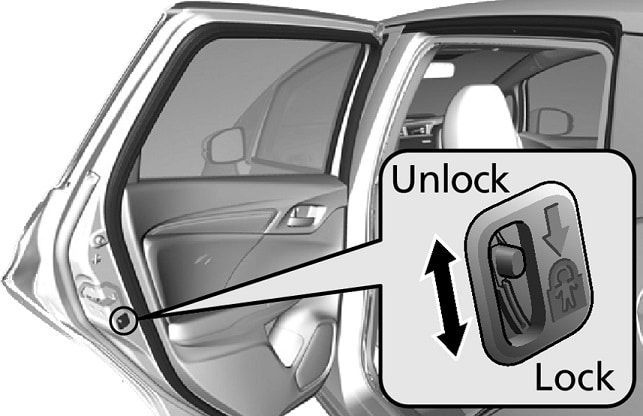Subjects:
- Door lock
- Central locking
- Child lock
door lock:
Door locks are mounted in the doors. These serve to open and close the doors. They also serve for safety, so that the door cannot just jump open in the event of an accident. The doors must be easy to open by emergency services in the event of an accident.
Door locks can be locked and unlocked mechanically with a key or electronically by a control device. The electronic control is often part of the central door locking system, which is discussed in the next section.
Door locks can only be removed with the inner trim removed. On older cars, the lock can be unscrewed from the outside, but that is too sensitive to crime. That is why disassembly is made as difficult as possible. Sometimes even the complete window mechanism must be completely disassembled with the window.
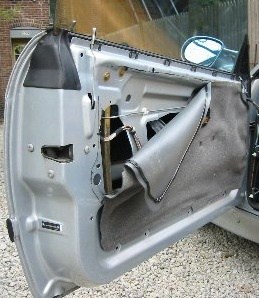
The image below shows a door lock module from two sides. This lock has a built-in electronic control device, which locks and unlocks the lock on command. At the top we see a locking clip for the bowden cable of the inner handle. The end of this cable is connected to the Bowden cable attachment. When the inner handle is operated, the release lever tilts to open the locking hook. The release lever of the outer handle is slightly less visible, but works in the same way. In addition, we see the wiring of the internal microswitch which registers the position of the locking hook, so that the interior lighting, the indicator lights and the alarm react to the opening of the lock. Finally we see the key operation; when you insert the key bit into the lock cylinder, the end of the key inserts into this slot. When it is possible to turn the key (the lock cylinder turns), this part in the lock module will turn to unlock or lock mechanically.

Central door locking:
In recent years, individual door locking has increasingly been replaced by central door locking. By manually operating the lock cylinder in the driver's door, the locks of the other doors and the tailgate are also actuated by being given the command “open” or “close”. Nowadays almost all cars are equipped with remote control. An extension of this is the automatic operation with a remote control or comfort access; no physical contact is required between the key and the vehicle to operate the central door lock.
The central door lock ensures that a locking catch in the door lock is moved. This can be done in various ways:
- pneumatic;
- electromagnetic;
- by an electric motor.
Pneumatic:
Until the late 80s and early 90s, there were manufacturers using vacuum controlled central locking. The position of the lock actuators was changed (opened or locked) by means of negative pressure. A diaphragm pump makes it possible to alternately pump an overpressure or underpressure. In each door lock there is a diaphragm chamber in which a locking catch is locked or unlocked, depending on whether there is an overpressure or underpressure in the chamber. This system is sensitive to leaks. Frequently opening and closing the doors, and thereby bending the vacuum hoses, can eventually lead to breakage. The sealing rubbers in the air chambers of the locks can also seal less well due to age. In the event of a leak, you can check the underpressure with a vacuum pump by closing one pipe at a time, or check the system with a smoke machine by detecting visible smoke.
The image below shows how many vacuum hoses were present in a Mercedes to pneumatically control the lock operation of the front doors and the tailgate.
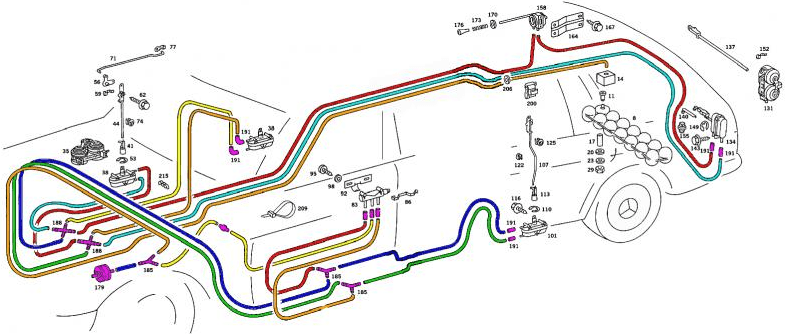
Electromagnetic:
With electromagnetic central door locking, door locks are equipped with double magnets. One magnet provides the upward movement and the other the downward movement to lock or unlock the lock.
By energizing the correct electromagnet (5 or 6) the locking pawl is pressed into the correct position: lock or unlock. Number 7 indicates the magnetic core.
This type of central door locking, like the pneumatic version, is no longer used. The undersigned has not been able to find any electrical diagrams of a vehicle that uses this system.
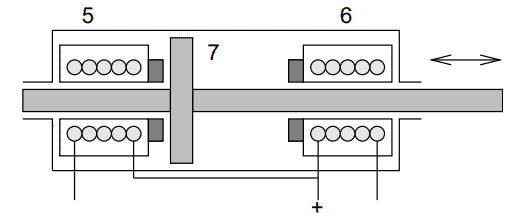
Electric motors:
The central locking of modern vehicles is equipped with electric motors. The rotating movement of the motor is converted into a rectilinear movement by a gear mechanism and a plastic mechanism. Usually these electric motors have no end stop and the mechanism jams against the stop and blocks the electric motor.
In order to lock or unlock the electric motor, the current direction, and thus the direction of movement of the electric motor, is reversed. The electrical diagram below shows the components in the central locking system of a modern car.
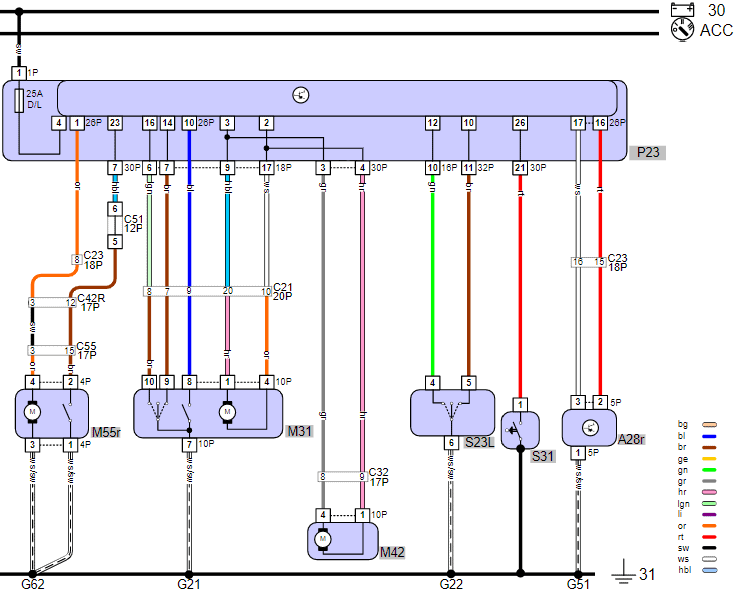
Description:
- 30: battery plus
- 31: mass
- ACC: switched plus (terminal 15)
- P23: on-board control unit
- M55r: tailgate lock unit
- M31: driver's door lock unit
- M42: door lock unit la
- S23L: central locking switch
- S31: door contact switch lv
- A28r: central locking receiver
This diagram shows the driver's door lock unit (M31) and the rear left door (M42) lock unit. In reality there are two more of these slot units (rv and ra) in the schematic, but they have been removed due to size. We also see the lock unit of the tailgate M55r) and the central locking switch (S23L) which is incorporated in the dashboard, center console or the door trim. The switch S31 is incorporated separately in the B-pillar, but on some cars this switch is incorporated in the lock unit. Finally, we see A28r: the radio receiver of the central locking in which the signal from the remote control is received. The control unit P23 processes the signals from the switches to control the locks and, if necessary, the lighting and indicator lights.
The two images below show a door lock of a Volkswagen Golf mk5, one unlocked and one locked. When locked, this type of lock can also be double locked, the so-called “safe lock”. This double locking is explained in the next section.
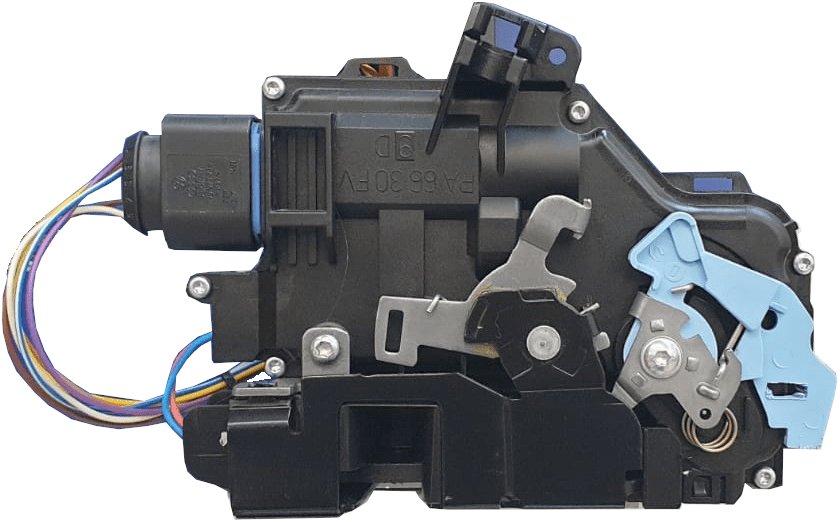
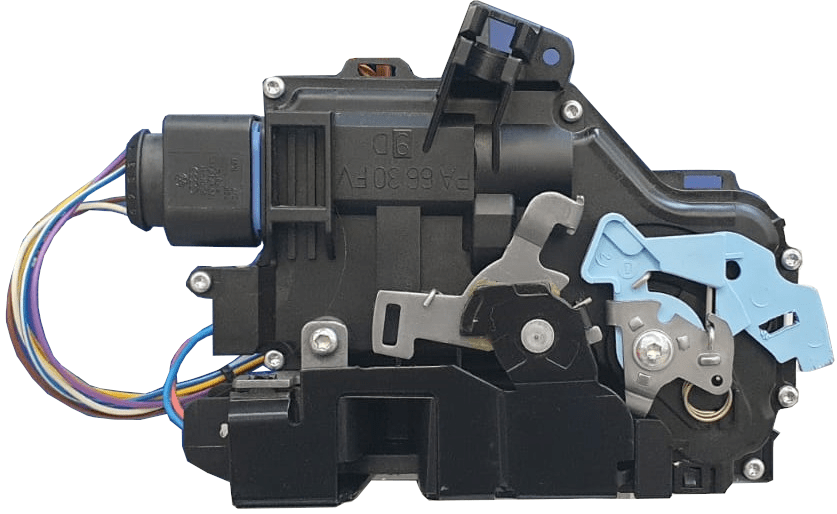
The moment you press the lock with the remote control, the double locking is activated. In the image above, the mechanism with the light blue plastic part rotates clockwise to the left. The lock can then no longer be unlocked if the double locking is not activated.
The double lock prevents the lock from unlocking when the inner handle is operated. This prevents someone who smashes a window from opening the door from the inside. Enabling the double lock can be different for cars:
- Pressing the lock button once on the remote control will lock the lock “normally”. Only when the lock button is pressed twice is the lock double locked;
- When you press the lock button for the first time, the lock is already double locked.
The following diagram shows the lock module (below) of a VW Golf mk5 with above it the control unit (A32m) which controls the lock.
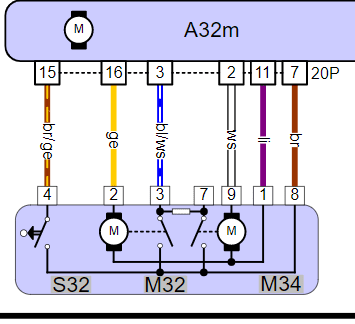
The two scope images below were recorded while locking and unlocking the door lock of this VW Golf.
- Channel A (blue) is connected to pin 9, the white wire to M34: this is the double lock motor;
- Channel B (red) is connected to pin 2, the yellow wire to M32: this is the interlock motor.
The first scope image was recorded when locking with the interior switch and the second with the remote control. The lock is locked at time t = 1,0 s in both scope images and unlocked at t = 3. In reality the time is multiplied by the number of ms/div; in this case 500. When locking with the interior switch, we see that the locking motor (red signal) ensures the locking of the lock, but that the double locking motor (blue signal) is not controlled. We can see that in the second scope image; the double locking motor is controlled. The lock is locked and unlocked with the remote control. With the double locking, the doors cannot be opened from the inside.
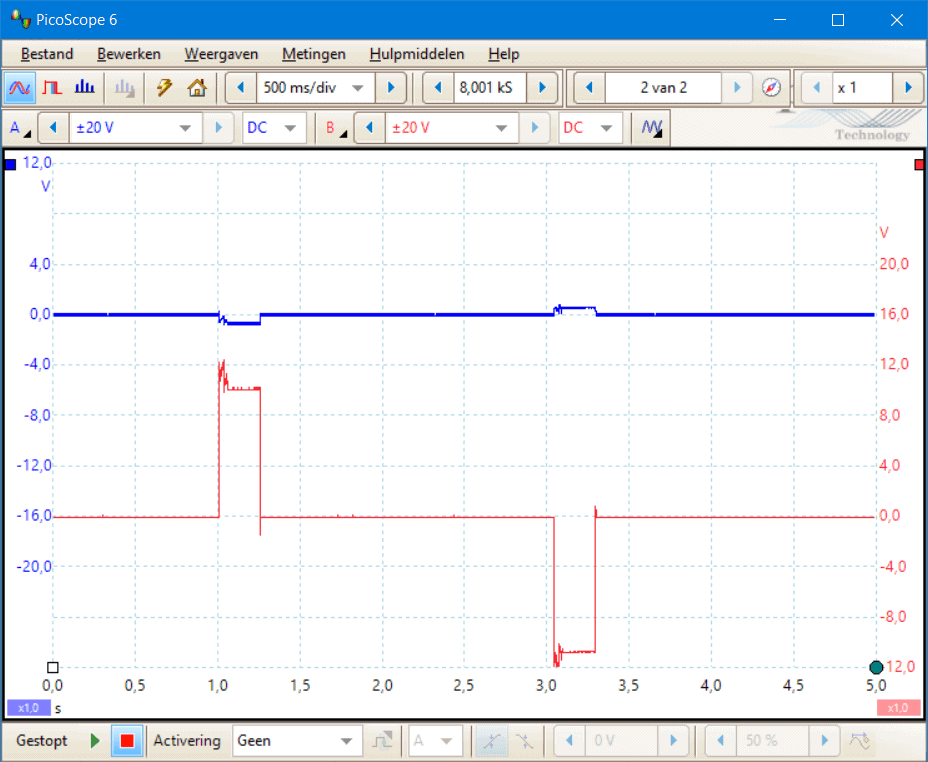
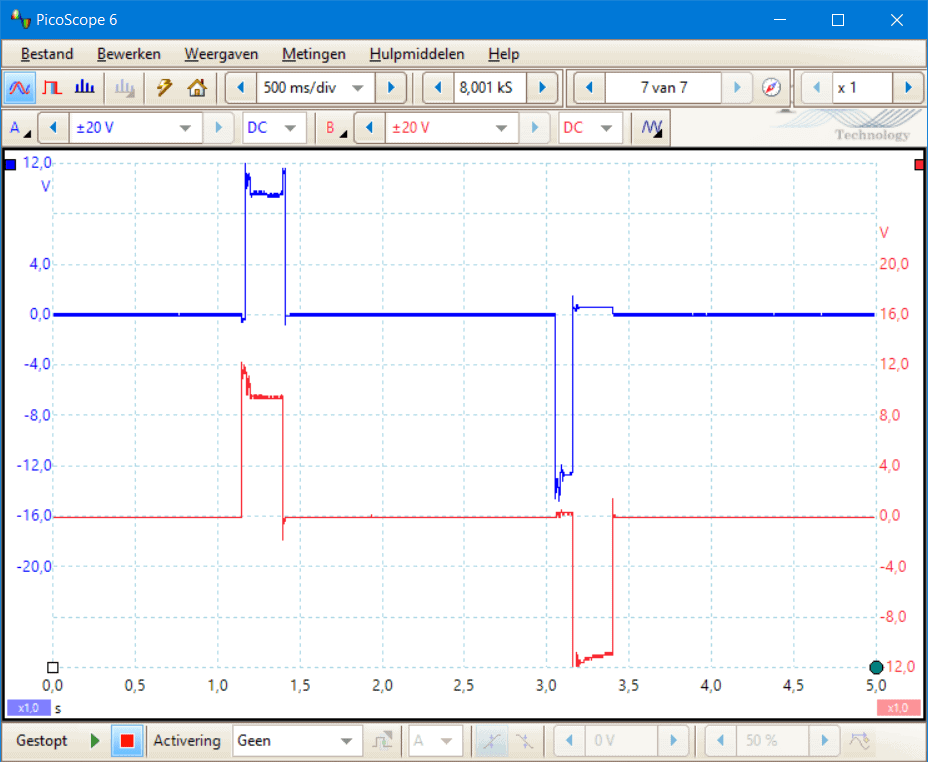
Child lock:
The rear doors contain a switch that activates the child lock. The rear passengers cannot open the door from the inside when the child lock is activated. When one operates the trade, there is no palpable resistance and nothing happens. Children cannot open the door themselves. The child lock works independently of the door locks; it therefore does not matter whether the locks are locked by means of the central door locking.
The type of switch depends on the manufacturer: sometimes it is a catch that can be moved with the fingers, other times the key has to be inserted into a slot to turn the switch.
